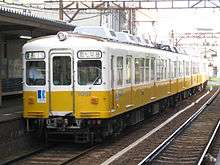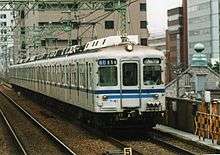Keikyu 1000 series
| Keikyu 1000 series | |
|---|---|
|
Set 1325 in May 2008 | |
| In service | 1959–2010 |
| Manufacturer | Kawasaki Heavy Industries, Tokyu Car Corporation |
| Constructed | 1958-1978 |
| Scrapped | 1986-2010 |
| Number built | 356 vehicles |
| Number in service | None |
| Number preserved | 2 |
| Formation | 2/4/6/8 cars per set |
| Capacity | 140 per car |
| Operator(s) | Keikyu |
| Specifications | |
| Car body construction | Steel |
| Car length | 18,000 mm (59 ft 1 in) |
| Width | 2,798 mm (9 ft 2 in) |
| Height | 4,050 mm (13 ft 3 in) |
| Doors | 3 single-leaf sliding doors per side |
| Maximum speed | 120 km/h (75 mph) |
| Weight | 35 t (including air conditioner) |
| Traction system | Resistor control |
| Power output | 75 or 90 kW per motor |
| Acceleration | 3.5 km/h/s |
| Deceleration | 4.0 km/h/s |
| Electric system(s) | 1,500 V DC |
| Current collection method | Pantograph |
| Safety system(s) | C-ATS |
| Track gauge | 1,435 mm (4 ft 8 1⁄2 in) |
The Keikyu 1000 series (京急1000形) was a DC electric multiple unit (EMU) train type formerly operated by the private railway operator Keikyu on commuter services in the Tokyo area of Japan from 1959 until June 2010.
Operations
The trains were used on the Keikyu Main Line, Keikyu Airport Line, Keikyu Daishi Line, Keikyu Zushi Line, and Keikyu Kurihama Line. They were also used on Toei Asakusa Line inter-running services until 2008. The last trains were withdrawn from service on 28 June 2010.[1]
Formations
The 1000 series fleet consisted of two-, four-, six-, and eight-car sets.[2] By 2010, only four- and six-car sets remained in service, formed as shown below.[3]
6-car sets
| Designation | M1c | M2 | M1 | M2 | M1 | M2c |
|---|---|---|---|---|---|---|
| Numbering | 1xxx | 1xxx | 1xxx | 1xxx | 1xxx | 1xxx |
The M1 and M1c cars each had one lozenge-type pantograph.[3]
4-car sets
| Designation | M1c | M2 | M1 | M2c |
|---|---|---|---|---|
| Numbering | 1xxx | 1xxx | 1xxx | 1xxx |
The M1 and M1c cars each had one lozenge-type pantograph.[3]
Interior
- The interior of a driving car in June 2010
- Priority seating (left) in June 2010
History
Four 800 series cars were built in 1958 as prototypes, based on the earlier 700 series design.[2] The type was subsequently reclassified "1000 series", with a further 352 vehicles built from 1959 to 1978. The early batches had non-gangwayed driving cabs with two windscreen panes, similar to the 700 series, but later batches included a centre gangway door at the cab ends.[2] Sets built from 1971 onwards had air-conditioning from new, whereas earlier sets were subsequently retrofitted with air-conditioning.[2]
Withdrawals commenced in 1986 with the arrival of 1500 series trains.[2] In 2008, one four-car set and one six-car set were repainted in early liveries to mark the 110th anniversary of Keikyu.[2]
 Set 1321 in special "History Gallery" livery in March 2008
Set 1321 in special "History Gallery" livery in March 2008- Set 1309 in special "Arigato gallery" livery in May 2008
A special farewell train ran on 27 June 2010, and the last 1000 series sets remained in operation until 28 June on the Daishi Line.[2]
- Keikyu 1000 series on the Daishi Line in June 2010, in the final weeks before withdrawal
Resale



A number of 1000 series cars were resold to the Takamatsu-Kotohira Electric Railroad ("Kotoden") in Shikoku, becoming the 1080 series and 1300 series. Other cars were also resold to the Hokuso Railway, becoming the Hokuso 7150 series.[2]
The identities and histories of the 1000 cars sold to Kotoden are as shown below.[2]
| Keikyu No. | Type | Withdrawn | Resold to Kotoden | Kotoden No. | Remarks |
|---|---|---|---|---|---|
| 1011 | M1 | 14 August 1988 | 14 December 1988 | 1081 | Cab donated from 1009 |
| 1012 | M2c | 14 August 1988 | 14 December 1988 | 1082 | |
| 1019 | M1 | 31 March 1989 | 8 July 1989 | 1083 | Cab donated from 1017 |
| 1020 | M2c | 31 March 1989 | 8 July 1989 | 1084 | |
| 1023 | M1 | 21 August 1989 | 19 December 1989 | 1085 | Cab donated from 1021 |
| 1024 | M2c | 21 August 1989 | 19 December 1989 | 1086 | |
| 1027 | M1 | 1 December 1989 | 28 June 1990 | 1087 | Cab donated from 1025 |
| 1028 | M2c | 1 December 1989 | 28 June 1990 | 1088 | |
| 1043 | M1 | 25 March 1991 | 14 August 1991 | 1091 | Cab donated from 1041 |
| 1044 | M2c | 25 March 1991 | 14 August 1991 | 1092 | |
| 1047 | M1 | 20 August 1990 | 19 April 1991 | 1089 | Cab donated from 1045 |
| 1048 | M2c | 20 August 1990 | 19 April 1991 | 1090 | |
| 1243 | M1c | 14 June 2010 | 31 August 2011 | 1307 | |
| 1250 | M2c | 14 June 2010 | 31 August 2011 | 1308 | |
| 1291 | M1c | 9 March 2007 | 28 June 2007 | 1303 | |
| 1298 | M2c | 9 March 2007 | 28 June 2007 | 1304 | |
| 1305 | M1c | 30 June 2010 | 31 August 2011 | 1305 | |
| 1308 | M2c | 30 June 2010 | 31 August 2011 | 1306 | |
| 1313 | M1c | 26 January 2007 | 27 June 2007 | 1301 | |
| 1316 | M2c | 26 January 2007 | 27 June 2007 | 1302 |
Preservation

Two 1000 series cars, 1351 and 1356, remain stored at Keikyu's Kurihama Works.[2]
References
- ↑ 京急1000形が営業運転を終える [Keikyu 1000 series withdrawn from revenue service] (in Japanese). Japan Railfan Magazine. 29 June 2010. Retrieved 29 June 2010.
- 1 2 3 4 5 6 7 8 9 10 Sato, Ryosuke (2014). 京急電車の運転と車両探見 [Examining Keikyu Train Operations and Rolling Stock]. Tokyo, Japan: JTB Can Books. p. 164–167, 175. ISBN 978-4-533-09705-8.
- 1 2 3 私鉄車両編成表 2010 [Private Railway Rolling Stock Formations - 2010]. Japan: Kotsu Shimbunsha. August 2010. p. 34. ISBN 978-4-330-15310-0.
External links
- Keikyu 1000 series information at the Wayback Machine (archived 24 July 2010) (in Japanese)
